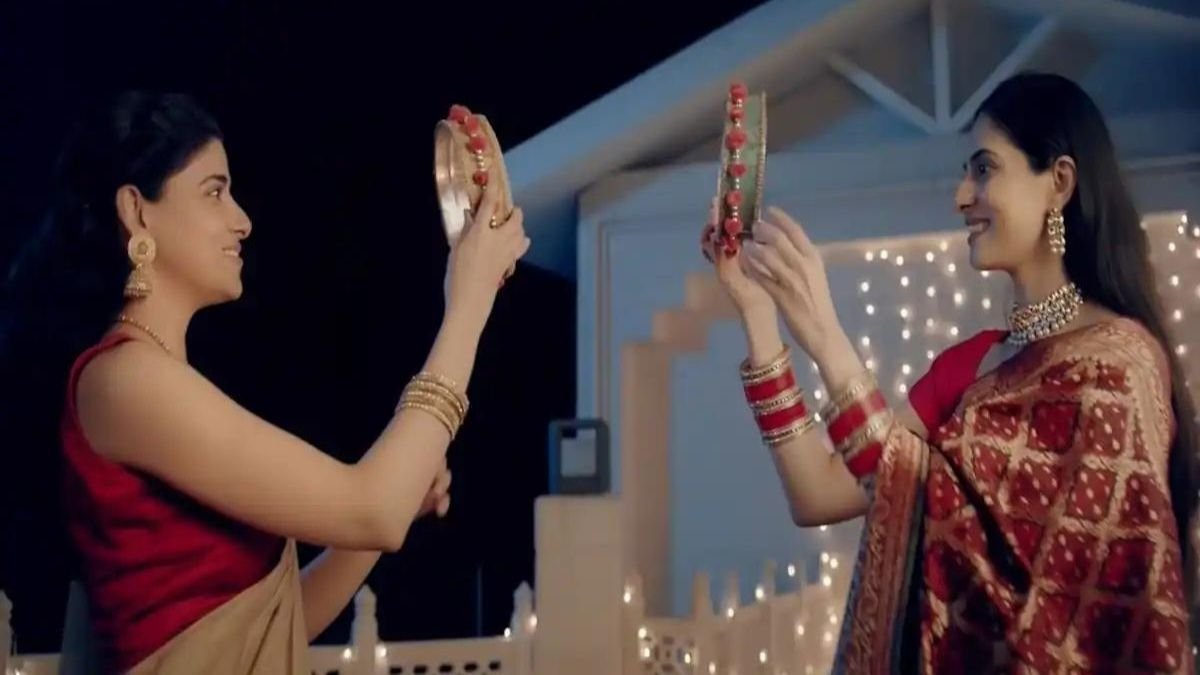Hinduism and same-sex marriage share a cordial relation, according to the religious texts. The world third most practised religion did not profess heteronormativity.
Today, while gazing through my Twitter feed, I non-surprisingly came across the boycott Fem trend because of their new Karva Chauth advertisement. The initial reaction was ok! Another so-called progressive Hindus sparked the controversy, as was in the case of Fabindia and CEAT. But the concoction of majorly professed Hinduism was different this time.
The Fem Gold Bleach ad has received backlash for professing inclusivity by featuring two women partners celebrating their first Karva Chauth together. The pro-Hindutva groups were saying that they were unaware of the Hindu culture for showing individuals who are tied in a same-sex marriage, getting ready for a Hindu festival.
The advertisement also received backlash for promoting fair skin, which is agreeable as most Indians have brown skin. Overall, it bagged mixed responses within a few hours of the release.
Same-sex marriage is considered against tradition and sastras in Hinduism. But, does it tarnish the religious texts that voiced space for everyone based on compassion and reciprocity?
Marriages and Dharmasastras
Let’s begin with what is Dharmasastras? According to Wikipedia, they are Sanskrit texts on law and conduct based on dharma. There are 18 to about 100 Dharmasastras with varying and conflicting points of view. They are guided and shaped by Vedas, tradition and wisdom. Therefore, they are changed constantly and updated in response to the political, economic and cultural demands. Thus, explaining the legitimacy behind Ram having only one wife, whereas Krishna had many wives.
Hinduism states the life is an expression of the soul or divine, known as atman in Hindi. But it is based on the concept of hierarchy, and life feeds itself on life. However, Dharma has the instinct to reverse it as said in Puranic literature. Manu, who is often viewed as a casteist, saved a small fish from being eaten by a big fish. According to Devdutt Pattanaik, the dharmas gave social expression to a civilizing idea, thus compassion and reciprocity forming the core ideals.
Marriages are important in Hinduism as it believes in the concept of re-birth. In Dharmasastras, marriages were celebrated as they helped to re-pay the ancestral debt by continuing the generation. Therefore, many sages abandoned their wife after the birth of their child.
Hinduism also has various interpretations of procreation – a distinct function in Hindu marriages. For offspring, they can adopt as King Janaka did. Lesbian couples can also adopt in-vitro fertilization methods for kids.
Procreation and partners in Hindu texts
Procreation is a method of producing kids or the process of reproduction. As mentioned, Hinduism believes in re-birth. Therefore it is important to get married and have kids. Since there is no explicit denial of same-sex marriages in the religion, the taboos are based on the idea and validation of the Hindu marriage concept.
Hindu sacred tests propagate the idea of companionship (Bandhu) or close friendship (Sakha or Sakhi) greater than mere friendship. Due to this, God always existed in pairs. But as history shows, they are always not heteronormative. For example, in Rig Veda, Lord Indra appears with Agni and Soma. All of them are male.
In another instance, two male Gods, Varuna and Mitra, spill semen in a pot on seeing Urvashi. Urvashi then gives birth to Agastya and Vasishtha. This process of procreation can be called replication of modern-day in-vitro fertilization. Also, in daily household rituals, we do witness female pairs of gods like Ganga-Gauri, Chamunda-Chotila.
Marriages and Heteronomous Relations
As marriages between the gods are a must, Lord Shiva marries Goddess Shakti. But he merges with Shakti to form Ardhanareshwara. Shiva also merged with Vishnu to be Hara-Hari as the latter takes the form of Mohini. Meanwhile, Vishnu is married to Lakshmi. Shiva fathers two sons – Ganesha and Kartikeya with Shakti, and fathers Lord Ayyappa with Vishnu. According to the Tantra sastra, Lakshmi adores Mohini, the female form of Lord Vishnu. Thus, Hindu sastra has never given importance to heteronomous relations.
Thus, those asking to ban the advertisement for including same-sex couples in a Hindu festival, kindly adore the core of a religion that never professes heteronormativity. The Vedas have referred to the third sex and defined them as people who do not indulge in procreative sex. But then it does not mention them as ostracized but voices them as people with divine power in certain situations.
If the above-mentioned arguments do not change or raise a question about the ban, then people should read Kama Sutra, the Hindu text on sexual pleasure. It mentions, “same-sex experience should be engaged in and enjoyed for its own sake as one of the arts.”


